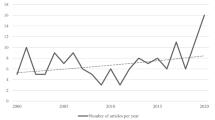Abstract
This paper makes an empirical contribution to the confirmation of the stylized fact that the performance of firms deteriorates in the years before exit. For this reason it is evaluated whether market exits differ significantly in their employment development in the years before market drop-out compared to surviving firms that have been selected using a non-parametric matching approach. The comparison of the employment growth rates among both groups reveals that the matched surviving firms experience higher growth rates compared to their exiting counterparts up to three years before market exit. Moreover, differences exist between Eastern and Western Germany due to various reasons.
Similar content being viewed by others
References
Almus, M., 2002, ‘What Characterizes a Fast Growing Firm?’, Applied Economics (forthcoming).
Almus, M., D. Engel and S. Prantl, 2000, ‘The “Mannheim Foundation Panels” of the Centre for European Economic Research (ZEW)’, Documentation 00-02, Centre for European Economic Research (ZEW), Mannheim.
Almus, M., S. Prantl, J. Brüderl, K. Stahl und M. Woywode, 2001, ‘Die ZEW-Gründerstudie — Konzeption und Erhebung’, Documentation 01-01, Centre for European Economic Research (ZEW), Mannheim.
Audretsch, D. B., 1995, Innovation and Industry Evolution, Cambridge.
Autorengemeinschaft, 1997, Arbeitsmarktentwicklung und aktive Arbeitsmarktpolitik im ostdeutschen Transformationsprozess 1990–1996, IAB Werkstattbericht 5, Nürnberg.
Brinkmann, C. und M. Otto, 1996, Überbrückungsgeld hilft arbeitslosen Frauen und Männern beim Sprung in die Selbständigkeit. Strukturmerkmale und Anhaltspunkte zum Erfolg der Fôrderung, IAB-Werkstattbericht 6, Nürnberg.
Brüderl, J., P. Preisendôrfer and R. Ziegler, 1992, ‘Survival Chances of Newly Founded Business Organizations’, American Sociological Review 57, 227-242.
BFLR [Bundesforschungsanstalt fuer Landeskunde und Raumordnung], 1995, ‘Materialien zur Raumentwicklung’, 67, Bonn.
Caves, R. E., 1998, ‘Industrial Organization and New Findings on the Turnover and Mobility of Firms’, Journal of Economic Literature 36, 1947-1982.
Dehejia, R. H. und S. Wahba, 1999, ‘Causal Effects in Nonexperimental Studies: Reevaluating the Evaluation of Training Programs’, Journal of the American Statistical Association 94, 1053-1062.
Evans, D. S., 1987, ‘The Relationship between Firm Growth, Size, and Age: Estimates for 100 Manufacturing Industries’, The Journal of Industrial Economics 35, 567-581.
Geroski, P. A., 1995, ‘What Do We Know about Entry?’, International Journal of Industrial Organization 13, 421-440.
Griliches, Z. and H. Ragev, 1995, ‘Firm Productivity in Israeli Industry 1979–1988’, Journal of Econometrics 65, 175-203.
Härdle, W., 1991, Smoothing Techniques With Implementation in S, Berlin.
Harhoff, D. and T. Koerting, 1998, ‘Lending Relationship in Germany — Emperical Evidence from Germany’, Journal of Banking and Finance 22, 1317-1353.
Harhoff, D., K. Stahl and M. Woywode, 1998, ‘Legal Form, Growth and Exit of West German Firms — Empirical Results for Manufacturing Construction, Trade and Service industries’, The Journal of Industrial Economics 96, 453-489.
Harvey, A. C., 1976, ‘Estimating Regression Models with Multiplicative Heteroscedasticity’, Econometrica 44, 461-465.
Heckman, J. J., R. J. LaLonde und J. A. Smith, 1999, ‘The Economics and Econometrics of Active Labor Market Programs’, in O. Ashenfelter und D. Card (Hrsg.), Handbook of Labor Economics 3a, Amsterdam, pp. 1865-2097.
Hujer, R., K.-O. Maurer and M. Wellner, 1997, ‘The Impact of Training on Unemployment Duration in West Germany’, Discussion Paper 74, Department of Economics, Johann Wolfgang Goethe-University, Frankfurt.
Jovanovic, B., 1982, ‘Selection and the Evolution of Industry’, Econometrica 50, 649-670.
Lechner, M., 1998, Training the East German Labour Force, Microeconometric Evaluations of Continuous Vocational Training After Unification, Heidelberg.
Lechner, M., 1999, ‘Earnings and Employment Effects of Continuous Off-the-Job Training in East Germany after Unification’, Journal of Business and Economic Statistics 17, 74-90.
Lechner, M., F. Pfeiffer, H. Spengler und M. Almus, 2001, ‘The Impact of Non-profit Temping Agencies on Individual Labour Market Success in the West German State of Rhineland-Palatinate’, in Lechner, M. und F. Pfeiffer (Hrsg.), Econometric Evaluation of Labour Market Policies, Heidelberg, pp. 211-242.
Maddala, G. S., 1983, Limited-Dependent and Qualitative Variables in Econometrics, Cambridge.
McCloughan, P., 1995, ‘Simulation of Concentration Development From Modified Gibrat Growth-Entry-Exit Processes’, Journal of Industrial Economics 43, 405-433.
Olley, G. O. and A. Pakes, 1996, ‘The Dynamics of Productivity in the Telecommunications Equipment Industry’, Econometrica 64, 1263-1297.
Pearl, J., 2000, Causality — Models, Reasoning, and Inference, Cambridge.
Prantl, S., 2001, Bankruptcy, Subsidized Loans, and Exit Decisions of Start-Up Firms, submitted Dissertation at the University of Mannheim, Mannheim.
Rajan, G. R. and L. Zingales, 1998, ‘Financial Dependence and Growth’, The American Economic Review 88, 559-586.
Rosenbaum, P. R. and D. B. Rubin, 1983, ‘The Central Role of the Propensity Score in Observational Studies for Causal Effects’, Biometrika 70, 41-55.
Roy, A. D., 1951, ‘Some Thoughts on the Distribution of Earnings’, Oxford Economic Papers 3, 135-146.
Rubin, D. B., 1974, ‘Estimating Causal Effects of Treatments in Randomized and Nonrandomized Studies’, Journal of Educational Psychology 66, 688-701.
Rubin, D. B., 1980, ‘Bias Reduction Using Mahalanobis-Metric Matching’, Biometrics 36, 293-298.
Schmalensee, R., 1989, ‘Inter-Industry Studies of Structure and Performance’, in R. Schmalensee and R. Willig (eds.), Handbook of Industrial Organization 2, Amsterdam.
Storey, D. J., 1994, Understanding the Small Business Sector, London.
Sutton, J., 1997, ‘Gibrats's Legacy’, Journal of Economic Literature 35, 40-59.
Verbeek, M., 2000, A Guide to Modern Econometrics, New York.
Wagner, J., 1999, ‘The Life History of Cohorts of Exists from German Manufacturing’, Small Business Economics 13, 71-79.
Wieflner, F., 2001, Arbeitslose werden Unternehmer, Beiträge aus der Arbeitsmarkt-und Berufsforschung 241, Nürnberg.
Author information
Authors and Affiliations
Rights and permissions
About this article
Cite this article
Almus, M. The Shadow of Death – An Emperical Analysis of the Pre-Exit Performance of New German Firms. Small Business Economics 23, 189–201 (2004). https://doi.org/10.1023/B:SBEJ.0000032033.00519.00
Issue Date:
DOI: https://doi.org/10.1023/B:SBEJ.0000032033.00519.00




